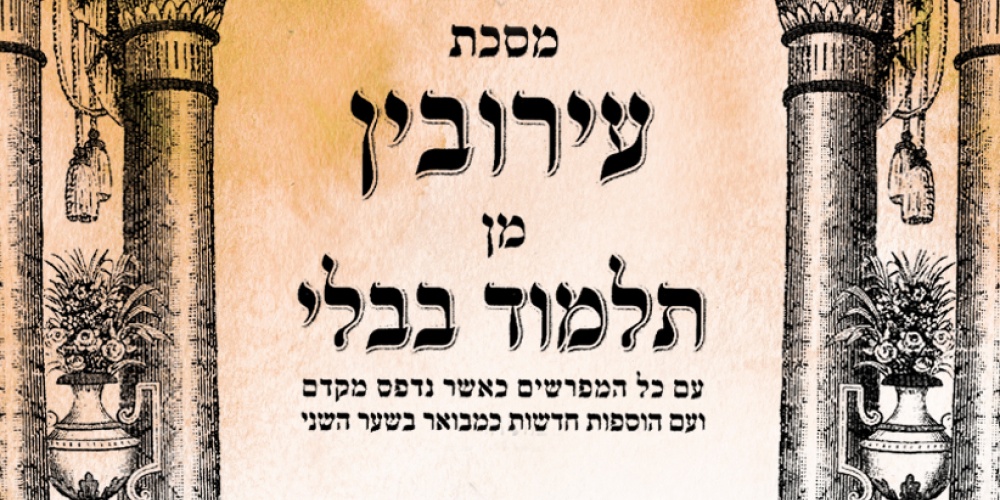
One of the key components of the legal discussions of the Talmud is the bringing of proof texts to support a given position. At times, the proof texts are from the Torah; at times from Nevi’im; and at times from Ketuvim. At all times, they lend authority to a stated position.
“Rav Chiya the son of Ashi said in the name of Rav: Whosever mind is not settled should not pray, as it says, ‘in distress one should not give rulings’” (Eiruvin 65a). Normally, when one studies Talmud and wants to see the source of a quoted verse, one looks to the side of the page, to the Torah Ohr. Compiled by the 16th century[1] Italian scholar Rav Yehoshua Boaz, the Torah Ohr lists the biblical source for every citation of a verse found in the Talmud[2].
Yet the Torah Ohr offers no source regarding our particular “verse”. Rashi, who lived centuries before (but did not need this tool) notes that, “I checked after this verse and it is not in any of the writings; perhaps it is in the Book of Ben Sira”.
Tosafot points out that in a number of places, the Talmud quotes from this non-biblical book. The Book of Ben Sira is a second-century BCE work containing many statements of wisdom, somewhat akin to the Book of Proverbs. Although it was not included in the biblical canon, it is worthy of being quoted in support of Jewish law. While (perhaps) unusual, this is further indication of the openness of our Sages to accepting knowledge from wherever it could be found.
However, the Mishnah (Sanhedrin 90a) rules that one may not read “outside books”, with Rabbi Akiva even claiming that one who does so has no share in the World to Come. The Mishnah, however, does not define what it means by “outside books”. The Gemara cites the view that these outside works refer to books of heresy such as those written by the Sadducees, who denied much of the Oral Law. The Gemara (ibid, 100b) then cites the view of Rav Yosef that these books refer to none other than the Book of Ben Sira. Rashi explains that, “it contains words of nothingness, and from them, one will come to neglect Torah study”.
Yet, interestingly, the Gemara has great difficulty explaining what the issue with this book might be, finding parallels in biblical texts to even the most “extreme” views of Ben Sira. Rav Yosef himself says a few lines later that “those uplifting words that are contained in it should be expounded upon”. Not surprisingly, this ruling of Mishnah forbidding the reading of “outside books” is not included in the codes.
Tosafot, on our daf in Eiruvin, quotes the opinion of Rabbeinu Tam that the Talmud often “shortens” a verse, and that the verse quoted in the Talmud is referring to a verse from the Book of Job: “Will you set up your prayer so that no trouble [befall you]?” (36:19). He acknowledges that this interpretation does not explain why the Talmud would use the word “yoreh”, to rule, as opposed to “yaroch”,[3] to pray.
Whether the proof text is from the Book of Ben Sira or that of Iyov ultimately makes little difference. If one is to approach G-d in prayer, a clear mind is required.
[1] Perhaps a work like this was not compiled earlier because there was no need for it. Talmudic students were expected to have mastery of the biblical text before they even opened up the Talmud. This system of study underwent major change in medieval Ashkenaz, with Rabbeinu Tam claiming that study of the Babylonian Talmud exempted one from spending much time in the study of Tanach (Kiddushin 30a). By the 16th century, the Maharal of Prague was lamenting the abandonment of the Mishnah’s ruling that one should only begin the study of Talmudic analysis at the age of 15—with early years spent mastering Tanach and the Mishnah. The level of Tanach knowledge today for many a Talmud student ranges from poor to abysmal.
[2] Rav Boaz also authored the Mesoret Hashas, listing all cross-references to parallel Talmudic passages. Doing this with a text as vast as the Talmud is beyond astounding, and the fact that the references he missed were later added by Rav Isaiah Pik Berlin, 18th century Rabbi of Breslau, Germany, only proves that he was human. Rav Boaz also authored the Ein Mishpat, Ner Mitzvah, referencing the relevant passages in Maimonides code and the Shulchan Aruch, a feat only a little less astounding. (It also includes references to the Sefer Mitzvot HaGadol of Rav Moshe Coucy, which—while obscure today—was a most important work of Jewish law). All three works—Torah Ohr, Mesorat HaShas and Ein Mishpat, Ner Mitzva—have been reprinted in every subsequent edition of the Talmud (with the additions of Rav Pik Berlin in square brackets).
[3] The pasuk in Iyov reads, בְצָר לֹא שׁוּעֲךָ הֲיַעֲרֹךְ; whereas the quote from Ben Sira is יורה אל בצר.
One of the key components of the legal discussions of the Talmud is the bringing of proof texts to support a given position. At times, the proof texts are from the Torah; at times from Nevi’im; and at times from Ketuvim. At all times, they lend authority to a stated position.



